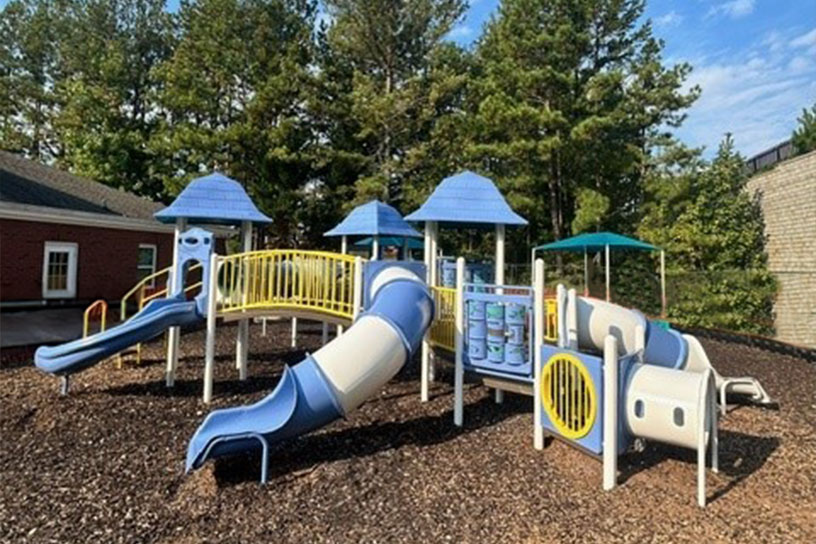Autumn's vibrant foliage and the playful rustling of leaves are synonymous with the season. However, as leaves fall from the trees and carpet the ground, they pose a unique challenge for playground safety. Wet leaves, in particular, can create slippery and hazardous conditions for children at play. In this comprehensive guide, we'll explore why it's crucial to keep wet leaves away from your playground, providing valuable insights, safety tips, and effective maintenance strategies.
Autumn brings about a stunning transformation in the world around us. Trees shed their leaves, painting the landscape with shades of red, orange, and yellow. The crunch of dry leaves underfoot and the joy of jumping into a pile of fallen foliage are cherished memories of the season. However, when these leaves become wet due to rain, dew, or other forms of moisture, they present a different set of challenges, especially in areas where children gather to play.
Wet Leaves and Playground Safety
Wet leaves can be deceptively slippery. When they accumulate on the ground in a playground, they create an environment where children are more likely to slip and fall. The increased risk of accidents can result in injuries, such as sprains, strains, and even fractures. It's essential to recognize the safety hazards that wet leaves can pose and take appropriate measures to mitigate them.
Understanding the Hazards of Wet Leaves
To fully grasp the importance of addressing wet leaves in a playground setting, it's crucial to delve into the specific hazards they introduce:
- Slippery Surfaces
Wet leaves turn the playground surface into a slippery terrain. Children running, jumping, or simply walking on these leaves are at risk of losing their footing and taking a tumble. This slipperiness can be particularly hazardous around play equipment and high-activity areas.
- Reduced Visibility
As wet leaves accumulate, they can obscure potential hazards on the ground, making it difficult for both children and supervisors to identify obstacles or irregularities in the surface. Reduced visibility increases the likelihood of accidents.
- Mold and Bacteria Growth
Wet leaves create a favorable environment for mold and bacteria to thrive. Prolonged exposure to these microorganisms can lead to health issues, especially in children with allergies or sensitivities. Preventing mold and bacteria growth is a vital aspect of keeping the playground safe.
- Allergen Concerns
In addition to mold, wet leaves can harbor other allergens, such as pollen and dust, which can affect children who have allergies or respiratory conditions. Maintaining a clean play area is essential to ensure the well-being of all children.
- Degradation of Playground Surfaces
Wet leaves can accelerate the deterioration of playground surfaces. They can lead to rot, rust, or wear and tear on equipment and surfaces, potentially necessitating costly repairs or replacements.
Strategies for Maintaining a Safe Playground
To ensure the safety and well-being of children, it's crucial to implement effective strategies for managing wet leaves in and around the playground. Here are some steps to consider:
- Regular Leaf Removal
Frequent leaf removal is key to maintaining a safe play environment. Establish a schedule for cleaning up fallen leaves, especially after rainy or dewy periods. Ensure that leaves are removed from high-traffic areas and play equipment.
- Proper Disposal
Disposed leaves should be collected and properly disposed of to prevent them from accumulating in nearby areas. Composting leaves can be an eco-friendly option, but it's essential to keep the composting area separate from the playground.
- Leaf Blowers and Rakes
Invest in leaf blowers and rakes to make the process of leaf removal more efficient. Regularly inspect and maintain this equipment to ensure it functions properly.
- Anti-Slip Measures
Consider using anti-slip coatings or mats in areas prone to wet leaves. These measures can help reduce the slipperiness of the surface and enhance traction.
- Educational Awareness
Teach children and caregivers about the potential hazards of wet leaves and the importance of being cautious when the ground is covered with them. Knowledge can empower children to make safer choices during play.
- Regular Inspections
Implement a routine inspection process to identify and address potential hazards, including wet leaves, in a timely manner. A well-maintained playground surface is a safer one.
Playground Safety and Wet Leaves: A Shared Responsibility
Playground safety is a collective effort that involves parents, caregivers, playground operators, and the community. It's important to foster a sense of shared responsibility for the well-being of children during playtime. By understanding the dangers of wet leaves and taking proactive steps to address them, we can ensure that our playgrounds remain safe and enjoyable places for children of all ages.
As autumn leaves adorn our world, it's essential to appreciate the beauty of the season while also being aware of the potential safety hazards wet leaves can introduce in playgrounds. By acknowledging the risks and implementing preventative measures, we can create a safer and more enjoyable environment for children. Remember that playground safety is an ongoing commitment, and by addressing the challenges posed by wet leaves, we can continue to provide a secure and fun place for children to play and explore.
If you have questions around preparing and maintaining a safe playground during the autumn months, don’t hesitate to contact our team of certified park inspectors at Playground Guardian. We can help ensure you’re doing everything you can to keep a safe environment for your visitors!





